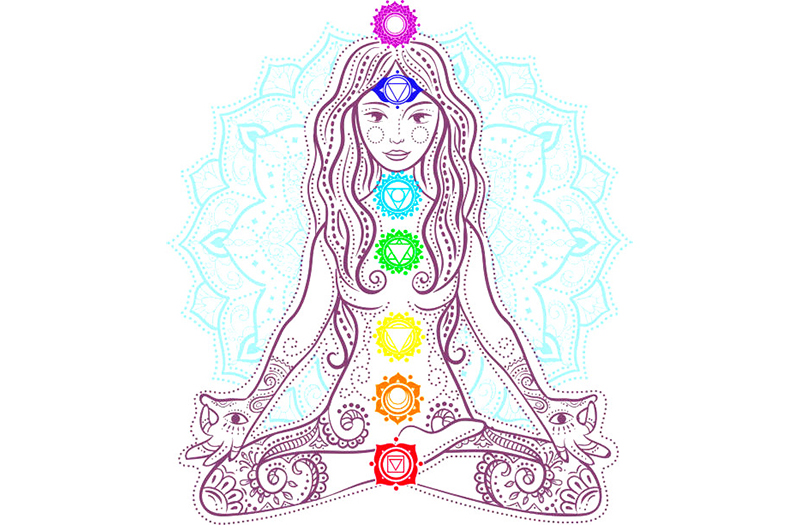Nadis
In simpler terms the Nadis are the arteries of the energetic body. The nadis are the fine subtle channels through which the energy flows to each part of our subtle body. They are often the subtle counterpart of the blood or nervous systems. From the point of view of the energy circulation through the body, all the nadis extract their energy from Ida and Pingala, which are the two functional modules that lie at the foundation of all mental, psychic and physical processes.
Nadis are the astral tubes made up of astral matter that carry psychic currents. The Sanskrit term ‘Nadi’ originates from the root ‘Nad’ which means ‘motion’. It is through these Nadis (Sukshma, subtle passages), that the vital force or Pranic current moves or flows. Since they are made up of subtle matter they cannot be seen by the naked physical eyes and you cannot make any test-tube experiments in the physical plane. Yoga Nadis are quite different from that of ordinary nerves, arteries and veins that are known to the Vaidya Shastra (Anatomy and Physiology).

The body is filled with innumerable nadis that cannot be counted. Different authors state the number of nadis in different ways, which range from 72,000 to 350,000. When we turn our attention to the internal structure of the body, we will be struck with a great wonder on seeing the intricacies as the architect happens to be the Divine Lord Himself who is assisted by skilled engineers and masons—Maya, Prakriti, Visva Karma, etc.
Nadis play a vital part in Yoga. Kundalini when awakened will pass through Sushumna Nadi and this is possible only when the nadis are pure. Therefore, the first step in Kundalini Yoga is the observation of the location, functions, nature, etc., as detailed knowledge of the nadis and chakras will help in restoring the purification of nadis.
The subtle (sukshma) lines (yoga nadis) have influence in the physical body. And these subtle prana, nadis and chakras have gross manifestation and operation in the physical body. The gross nerves and plexuses have a close relationship with these subtle ones. Since the physical centers have a close relationship with the astral centers, the vibrations that are produced in the physical centers by prescribed methods, have the desired effects in the astral centers.
Wherever there is an interlacing of several nerves, arteries and veins, that center is called “Plexus”. The physical material plexuses that are known to the Vaidya Shastra are: Pampiniform, Cervical, Brachial, Coccygeal, Lumbar, Sacral, Cardiac, Esophageal, Hepatic Pharyngeal, Pulmonary, Ligual Prostatic Plexus, etc. Similarly there are plexuses or centers of vital forces in the Sukshma Nadis. They are known as ‘Padma’ (lotus) or Chakras. All the Nadis spring from the Kanda, which is in the junction where the Sushumna Nadi is connected with the Muladhara Chakra. According to few this Kanda is twelve inches above the anus. Out of the innumerable Nadis, there are fourteen important ones and they are:
- Sushumna
- Ida
- Pingala
- Gandhari
- Hastajihva
- Kuhu
- Saraswati
- Pusha
- Sankhini
- Payasvini
- Varuni
- Alambusha
- Vishvodhara
- Yasasvini
Ida, Pingala and Sushumna are the most important and Sushumna is the chief, which is the highest and most sought by the Yogins. Other nadis are subordinate to this.
When we study the construction, location and function of the spinal cord and the Sushumna nadi, we can easily conclude that the Spinal Cord is called Sushumna nadi by the yogins of yore. The western anatomy deals with the gross form and functions of the spinal cord, while the yogis of ancient times dealt with the subtle (sukshma) nature. Now in Kundalini Yoga, we need to have a thorough knowledge of this nadi.
Sushumna extends from the muladhara chakra (second vertebra of coccygeal region) to brahmarandhra. The Western Anatomy admits that there is a central canal in the spinal cord, known as Canalis Centralis and that the cord is made up of grey and white brain-matter. The Spinal Cord is dropped or suspended in the hollow of the spinal column. In the same way, sushumna is dropped within the spinal canal and has a subtle section which is of red color like Agni (fire).
Within this sushumna there is a nadi by the name of Vajra which is lustrous as Surya (sun) with Rajasic qualities. Again within this Vajra Nadi, there is another nadi, called Chitra. It is of Sattvic nature and of pale color. The qualities of Agni, Surya and Chandra (fire, sun and moon) are the three aspects of Sabda Brahman. Here within this Chitra, there is a very fine minute canal (which is known as Canalis Centralis). This canal is known as Brahmanadi, through which Kundalini, when awakened, passes from Muladhara to Sahasrara Chakra. In this center, there exists all the six Chakras (lotuses, viz., Muladhara, Svadhishthana, Manipura, Anahata, Vishuddha and Ajna).
The lower extremity of the Chitra Nadi is called Brahmadvara, the door of Brahman, as Kundalini has to pass through this door to Brahmarandhra. This corresponds to Haridwar which is the gate of Hari of Badrinarayan in the macrocosm (physical plane). The Chitra terminates in the Cerebellum.
In a general sense the Sushumna Nadi itself (gross Spinal Cord) is called Brahma Nadi because, Brahma Nadi is within the Sushumna. Again the canal within the Chitra is also called Sushumna, because the canal is within the Sushumna. Ida and Pingala nadis are on the left and right sides of the spine.
Chitra is the highest and most beloved of the Yogis. It is like a thin thread of lotus. Brilliant with five colours, it is in the center of Sushumna. It is the most vital part of the body. This is called the Heavenly way. It is the giver of Immortality. By contemplating on the Chakras that exist in this nadi, the Yogi destroys all sins and attains the Highest Bliss. It is the giver of Moksha.
When the breath flows through Sushumna, the mind becomes steady. This steadiness of the mind is termed “Unmani Avastha”, the highest state of Yoga. If you sit for meditation when Sushumna is operating, you will have a wonderful meditation. When the nadis are full of impurities, the breath cannot pass into the middle Nadi, hence we practice Pranayama for the purification of Nadis.
Sushumna nadi, the central channel around which the two other nadi “revolve” is the royal path through which the experience of the ultimate state of consciousness happens, that will lead to our transformation.
Each cell of our body, each organ, the brain and the mind, all the “elements” of our being are interconnected at a physical and subtle level, which allows us to think, talk, act and exist in a balanced, coherent, and synchronic manner, wherein each part acts for the benefit of the other parts. Inside our body, there are two energetic systems that control this process. They develop around Ida and Pingala nadi, and if we stimulate one element of this system, through the process of resonance, we will activate the whole system.

Sympathetic & Para-sympathetic Nerve Ganglia
On either side of the spinal cord run the sympathetic and para-sympathetic cords, a double chain of ganglia. Ganglia meaning a collection of nerve-cells. These nerves are connected to all other vital systems of the body to regulate their functioning. These constitute the Autonomic System which supplies nerves to the involuntary organs, such as the heart, lungs, intestines, kidneys, liver, etc., and controls them. The Vagus nerve which plays a vital part in human economy comes out of this sympathetic system. The Sympathetic system stimulates or accelerates. The Para-sympathetic system retards or inhibits. There are nerves to dilate or expand the arteries which carry pure oxygenated blood to nourish the tissues, organs and cells of different parts of the body. These are called Vaso-dilators. The left and the right sympathetic chains are connected by filaments. These cross from the right to the left side and vice versa, but the exact places where these crosses is not known, though several have attempted to find them. M’Kendrick and Snodgrass in their Physiology of the Senses write: “Where the sensory fibres cross from one side to the other is not known ….. In some parts of the spinal cord the sensory fibres do cross from the right to left side and vice versa.”
Canalis Centralis — Brahma Nadi
Within the Chitra Nadi, there is a very fine minute canal (which is known as Canalis Centralis in the Spinal Cord). This canal is known as ‘Brahmanadi’, through which Kundalini, when awakened, passes from Muladhara to Sahasrara Chakra. The lower extremity of Chitra Nadi is called ‘Brahmadvara’, through which Kundalini passes to ‘Brahmarandhra’ (Central Sulcus in the Brain) which is in Sahasrara Chakra. The dormant serpent poses it’s mouth towards this Brahmadvara and goes into hybernation; waiting for the awakening period.

Ida & Pingala Naadis
These nadi’s are present on either side of Sushumna Nadi, which resembles the Sympathetic and Para-Sympathetic Nerves, which are present on either side of the Spinal Cord. Ida starts from the right testicle and Pingala from the left testicle. They meet with Sushumna nadi at Muladhara Chakra and make a junction. This junction of the three Nadis is known as Mukta Triveni.
Ida flows through the left nostril and Pingala through the right nostril to their ‘origin of place’. Ida is also called Chandra Nadi (moon) and Pingala as Surya Nadi (sun). Ida is cooling and Pingala is heating. Ida is of pale and shakti rupa (energy giver). Pingala is of fiery red and Rudra Rupa.

Cauda Equina — Kanda
The spinal cord extending from the brain to the end of the vertebral column tapers off into a fine silken thread. Before its termination it gives off innumerable fibers, crowded into a bunch of nerves. This bunch of nerves is called ‘Cauda equina’.
In the physical body, Kanda is situated between the anus and root of the reproductory organ ( where exactly the Cauda Equina exists as a bunch of nerves.) It is like the shape of an egg and is covered with membranes. All the nadis of the body spring from this Kanda. It is the junction where Sushumna is connected with the Muladhara chakra. The four petals of the Muladhara Chakra are on the sides of this Kanda and the junction is called ‘Granthi-Sthana’, where the influence of Maya (materialistic happiness ) is very strong.
Shat Chakras
These are the STORE HOUSES OF COSMIC ENERGY. These Shatchakras are Muladhara, Swadhishtana, Manipura, Anahata, Visudda, & Ajna. All of these are present at their specific regions along the length of Sushumna nadi.
Conclusions
The Brain and Spinal Cord are connected by the Medulla Oblongata, which is present in-between, as a connecting link. The Spinal cord opens into the brain through the medulla oblongata, then from the fourth ventricle it runs to the third, then to the fifth ventricle of the brain, which is the last stage.Thus the entire Nervous System exists on the same meridian, on a single line starting from the Brain to the Cauda Equina.
Brahma Nadi in Sushumna Nadi is extended to brahmarandhra (Central Sulcus in the brain) which is in the Sahasrarachkra .Thus the entire Kundalini System exists on the same meridian, on a single line starting from Sahasrara Chakra to Kanda.
Like how the physical nervous system has the accessorial organs like a plexus and network throughout the physical body to carry out the assigned functions, the astral system also has sub nadis to the major nadi’s, and plexuses at different parts of the body for proper supply and regulation of Pranic or Astral energies or Life Force.
